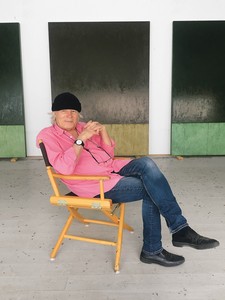
Brice Marden
Larry Gagosian celebrates the unmatched life and legacy of Brice Marden.
Spring 2019 Issue
Paul Goldberger tracks the evolution of Mitchell and Emily Rales’s Glenstone Museum in Potomac, Maryland. Set amid 230 acres of pristine landscape and housing a world-class collection of modern and contemporary art, this graceful complex of pavilions, designed by architects Thomas Phifer and Partners, opened to the public in the fall of 2018.
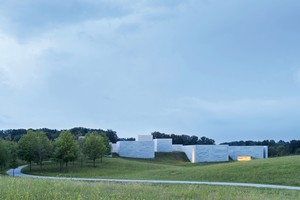
Glenstone Museum. Photo: Thomas Phifer
Glenstone Museum. Photo: Thomas Phifer
When Mitchell Rales opened the first section of his private museum on the grounds of a former fox-hunting club in Potomac, Maryland, in 2006, he referred to it as “miles away from the nearest museum” and said that “Glenstone will, I hope, become a destination for lovers of art, and its location will not detract from the experience, but add to its distinct character.” The beginnings of Glenstone were hardly modest: Rales commissioned the architect Charles Gwathmey to design a 23,000-square-foot gallery structure on the lush, rolling hills of the 150-acre property, along with a house for him, and the gallery opened with an exhibition that included significant works by Jackson Pollock, Mark Rothko, Franz Kline, Alberto Giacometti, Cy Twombly, Ellsworth Kelly, Alexander Calder, Donald Judd, and Willem de Kooning, all from Rales’s collection of postwar art. What appeared in the Maryland countryside back then, however, barely hinted at what was to follow.
Over the following decade, Rales and his curator, Emily Wei—who became his wife in 2008—would build Glenstone into one of the most unusual private museums in the country, with a series of in-depth exhibitions of the work of artists such as Fred Sandback, Roni Horn, and Peter Fischli and David Weiss, as well as commissioned sculptures by Kelly, Richard Serra, Jeff Koons, Andy Goldsworthy, and the estate of Tony Smith for the meticulously landscaped grounds. Glenstone quickly earned a reputation within the art world as a place that treated contemporary art with the gravitas, not to say the connoisseurship, of an academic institution rather than with the self-indulgence typical of many private museums established by wealthy collectors. Rales, a billionaire who made his fortune through the Danaher Corporation, a conglomerate that owns numerous industrial and technology companies, deliberately did not name the museum after himself: the name is an amalgam of the address, on Glen Road, and the area’s historical role as home to several stone quarries. The idea from the beginning was to focus on the art, not the collector, and to give the place a tone that was discreet and quiet, where the only thing that might possibly compete with the art was nature. Glenstone, like its founder, made a point of staying below the radar.
It is below the radar no more. Last fall, Mitch and Emily Rales unveiled to the world a vastly expanded Glenstone, which has grown from Gwathmey’s medium-sized gallery into a 170,000-square-foot museum, nearly the size of the Whitney in New York. Although it is permanently endowed by the Raleses and will contain their collection in perpetuity, it is now less a private gallery than a full-fledged museum. If anything, Glenstone 2.0 is even more single-minded in its commitment to treating art created since 1945 with both scholarly reverence and curatorial respect. And its patrons by choice remain, if not nearly invisible as before, very much in the background.
The level of architectural ambition has ramped up, too. Gwathmey died in 2009, after making preliminary sketches for the expanded museum the Raleses were just beginning to think about at that point; feeling that his ideas were insufficiently developed to be completed by anyone else, they decided to start all over again, embarking on a search that brought them to the New York–based architect Thomas Phifer, whose pristine, elegant buildings of glass had brought him wide respect but who at that time had done only one major museum, the North Carolina Museum of Art. (Full disclosure: I served as advisor to the Raleses in their search for an architect in 2010.)
Phifer, who once worked for Gwathmey, designed the new Glenstone in the form of a series of discrete concrete boxes arranged around a glass-enclosed courtyard with a reflecting pool. All but one of these galleries are devoted to the work of a single artist. The Gwathmey structure remains as a secondary exhibit space, designated The Gallery; in recognition of the new building’s villagelike arrangement of eleven separate galleries that read almost as distinct buildings, it is called The Pavilions. The program has also been expanded to include conservation areas, offices, and storage facilities, none of which was available in the original building. Completing the expansion are two additional structures, one a small café, the other an entry pavilion and bookstore.
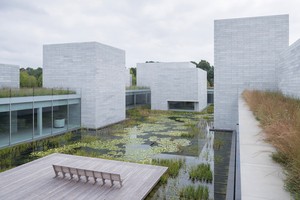
Glenstone Museum. Photo: Thomas Phifer
That the program for the new Glenstone required a separate entry pavilion tells as much, in its way, about how this institution has evolved as anything about its exhibit spaces. Mitchell Rales had always cited the Louisiana Museum of Modern Art, outside Copenhagen, as one of the museums he most admired, in part because of its integration of art, modern architecture, and landscape, and Glenstone’s pristine landscape, designed by Peter Walker and Adam Greenspan of PWP, has been part of the allure of a visit from the early days. But how to preserve the sense of quietude, of peace and calm, when the museum was more than quadrupling in size and the expected visitor count going from a few thousand a year to roughly a hundred thousand? Part of the solution was to limit visitors to four hundred at any one time through prereserved time slots, but to be on the safe side, the Raleses also decided to add more nature to Glenstone as well as more architecture. They expanded the property to 230 acres, purchasing not only adjacent empty land but also several lots already developed with McMansions, which they proceeded to tear down. Then Phifer, working with Walker and Greenspan, designed a site plan that reoriented the property to create a new visitors’ entrance that keeps cars far away from the museum itself.
The first impression of Glenstone is not of a museum at all, but of a huge country estate, with a long entry drive leading to several discreet parking areas, each set into the landscape and named for a different tree. Beside the third small lot is Phifer’s crisply elegant arrival pavilion, a domestically scaled hint of the larger architectural experience to come. The museum itself is nowhere visible. You begin a walk through an exquisite meadow of tall grasses that curves across a bridge over a small stream, and then bends again, at which point, in the distance, the sharply outlined forms of Phifer’s museum come into view, a cluster of small gray boxes set into the far hillside, only to disappear again as the pathway curves. It is a moment of quiet, intense drama that pulls you forward.

Jeff Koons, Split-Rocker, 2000, stainless steel, soil, geotextile fabric, internal irrigation system, and live flowering plants, 37 × 39 × 36 feet (11.3 × 11.9 × 11 m) © Jeff Koons. Photo: courtesy Glenstone Museum
The walk, which takes a few minutes (there are golf carts for those who cannot approach on foot), is like no approach to any other museum anywhere, including the Louisiana. You are fully immersed in nature, and only the view of Koons’s Split-Rocker (2000), an immense floral sculpture that is itself a kind of conceit built around nature, competes with the soft, flowing landscape. And then the museum is visible again, this time larger and closer up, and you can see the delicate balance of the composition of boxes tall and short, horizontal and vertical, and the silvery-gray surface of the concrete, too rough to be smooth, too smooth to be rough: an arrival that manages at once to be monumental and understated. The façade is made of poured-concrete blocks, each one foot high, one foot deep, and six feet long, and they are stacked like huge Roman bricks, with quarter-inch open joints, a proportion that gives the building both texture and scale. The unusual size was carefully chosen to be neither too large nor too small, and to underscore the way in which the building bridges grandeur and intimacy.
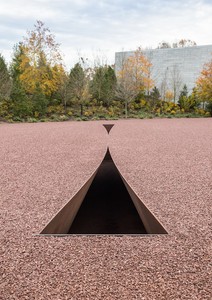
Michael Heizer, Compression Line, 1968/2016, A588 steel, 75 × 10 × 9 ½ feet (22.9 × 3 × 2.9 m) © 2018 Michael Heizer. Photo: Eric Piasecki
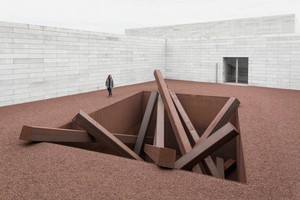
Michael Heizer, Collapse, 1967/2016, A588 steel, 36 × 24 × 16 feet (11 × 7.3 × 4.9 m) © 2018 Michael Heizer. Photo: Eric Piasecki
The path rises slightly as it approaches the main entry, which is actually on the roof of the gallery and office level. There is a view down to one of Glenstone’s special pieces, Michael Heizer’s Compression Line (1968/2016), set into the ground beside the museum. An entry pavilion leads you into a hall that is quiet and formal, with only a wall piece by Lawrence Weiner and a wide stone staircase down to the main gallery level. The experience of the stair, tall and narrow, is counterintuitive, since as you descend you move to more, not less, daylight, and toward less enclosure as the space opens up again and the vista of the water court, with its reflecting pool planted with lilies and rushes, reveals itself. The stair is really the second part of the processional movement toward art that began with the walk from the arrivals building: first you go across the landscape, and then you descend the staircase, an act that feels like burrowing into the earth but in fact turns out to be one of revelation: with the art is light. You descend to metaphorically rise.
And there begins the sequence of galleries, set around the water court. The pavilions are connected by an interior passageway, twelve feet high and varying from fifteen to twenty-four feet wide, with walls of glass facing the water court, so that the minimalist landscape and the shimmering surface of the reflecting pool are always in view as you move from pavilion to pavilion, and there is always some degree of spatial change: since the pavilions themselves vary in width, depth, and height, the passageway is not a simple or straight corridor but a spatial experience that varies just enough to maintain a sense of surprise, but never so much as to disrupt the sense of serenity that, at Glenstone, only the art is expected to challenge.
The architecture is powerful but the focus is nevertheless always on the art, and on the dialogue between the two: the architecture provides a setting that is simultaneously imposing, enlivening, and respectful.
The first pavilion, the largest, is designed for temporary exhibitions, and Emily Rales curated the inaugural show of highlights from the couple’s collection. It begins with the classic Abstract Expressionism that Mitchell Rales first collected: the first section contains, among other things, a magnificent 1957 Kline and Pollock’s Number 1, from 1952—and moves on to Rothko, Judd, Jasper Johns, Robert Rauschenberg, Sol LeWitt, Frank Stella, Andy Warhol, Agnes Martin, Bruce Nauman, Barbara Kruger, and more contemporary pieces by David Hammons, Martin Kippenberger, and Rosemarie Trockel, among others. It is a majestic and powerful survey of the second half of the twentieth century.
The other pavilions are permanent or quasi-permanent installations, in most cases the work of a single artist. The spaces are designed in response to the needs of the pieces themselves, which are mostly of more recent vintage than the art in the first pavilion. The first is more of a light tower than a full gallery, a small, thirty-six-foot-high room holding the Japanese conceptual artist On Kawara’s Moon Landing triptych (1969), which marks the key dates of the Apollo lunar mission and is one of the few of the artist’s Date Paintings intended to work as a set. Next is a large pavilion of more conventional height with a large installation by Robert Gober that includes a mural of a forest and eight industrial sinks with their faucets running; then a roofless pavilion with a powerful Heizer work, Collapse (1967/2016), an extraordinary installation consisting of fifteen steel beams installed at seemingly random angles within an open rectangular pit.
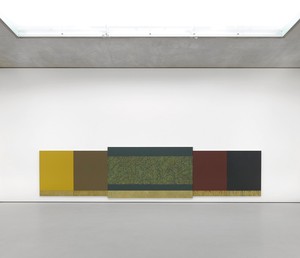
Brice Marden, Moss Sutra with the Seasons, 2010–15, oil on linen, five panels, overall: 108 × 468 inches (274.3 × 1188.7 cm) © 2018 Brice Marden/Artists Rights Society (ARS), New York. Photo: Ron Amstutz, courtesy Glenstone Museum

Installation view of works by Cy Twombly in the Glenstone pavilions. Artwork © Cy Twombly Foundation. Photo: Ron Amstutz, courtesy Glenstone Museum
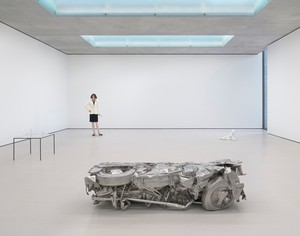
Installation view of works by Charles Ray in the Glenstone pavilions. Artwork © Charles Ray, courtesy Matthew Marks Gallery. Photo: Ron Amstutz, courtesy Glenstone Museum
The sequence of pavilions continues with a room containing a video and sound installation by Pipilotti Rist, Ever Is Over All (1997); a pavilion for Charles Ray, whose fifteen-ton sculpture Baled Truck (2014) required shoring up of the concrete wall from below; Brice Marden’s Moss Sutra with the Seasons (2010–15), a five-panel painting specifically commissioned for the space; Lygia Pape’s 1961 Book of Time, a wall of 365 small abstract reliefs; and a pavilion devoted to Twombly that contains none of his well-known paintings but, instead, five of his lesser-known, elegant sculptures.
All of the pavilions are lit by natural light, controlled differently depending on the height, proportions, and artistic needs of each space. Roughly midway in the sequence there is an opportunity to take a break and step onto a platform within the water court, and as an added counterpoint there is also a small pavilion with a wall of glass facing out to the landscape and containing a voluptuous, curving bench of cedar made by Martin Puryear and Michael Hurwitz. It doubles as a reading room, with maple paneling and a wall of books.
Glenstone resembles no other contemporary museum, although Phifer’s exquisite detailing and masterful ability to evoke at once lightness and gravitas make it hard not to think of Tadao Ando’s concrete, the sensuousness of which is almost equaled by Phifer’s more textured concrete blocks. There are echoes, too, of the resonance of Louis Kahn’s sublime combinations of wood and stone, as well as of his subtle use of natural light.
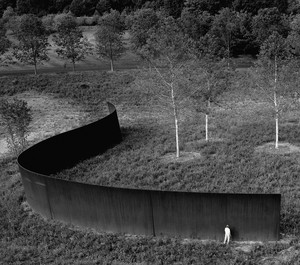
Richard Serra, Contour 290, 2004, weatherproof steel, 15 feet 9 ½ inches × 223 feet 2 inches × 2 inches (4.8 m × 68 m × 5.1 cm) © 2018 Richard Serra/Artists Rights Society (ARS), New York. Photo: Lorenz Kienzle
But the museum that Glenstone really calls to mind, surprisingly, is one that would seem to be its exact opposite: John Russell Pope’s original building for the National Gallery of Art in Washington, DC, completed in 1941, an ode to classicism that, on the surface at least, comes from another world than Glenstone. And the art it contains is as different from Glenstone’s as its architectural style. But the two museums both possess a kind of majestic dignity that coexists with relaxed, easy movement, a combination rare in museums of any period. And they could both be considered to be exceptionally knowing essays on the processional nature of museum-going. Pope’s sumptuous galleries are set around garden courts, like Phifer’s, and they vary in size and shape, both to accommodate different scales of painting and to allow the visitor a constant sense of visual and emotional relief. The architecture is powerful but the focus is nevertheless always on the art, and on the dialogue between the two: the architecture provides a setting that is simultaneously imposing, enlivening, and respectful. No museum for contemporary art has yet equaled the combination of dignity and grace that Pope achieved, or provided the same combination of serenity and energy. Phifer’s museum, like Pope’s, is built on the idea that museum design is about movement more than stasis, yet he understood, like Pope, that the architect has to serve the pleasures of contemplation as much as the idea of movement. At the National Gallery of Art, Pope built the greatest museum building of the mid-twentieth century, swathed in classical garb; at Glenstone, Phifer has reinterpreted it for the twenty-first century—and, in so doing, has made one of the triumphant museum buildings of our time.
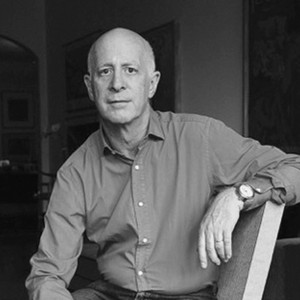
Paul Goldberger, whom the Huffington Post calls “the leading figure in architecture criticism,” won a Pulitzer Prize for his writing in the New York Times. The author of several books, including Why Architecture Matters and Building Art: The Life and Work of Frank Gehry, he has also served as architecture critic for the New Yorker and Vanity Fair, and he holds the Joseph Urban Chair in Design and Architecture at the New School, New York. Photo: Michael Lionstar

Larry Gagosian celebrates the unmatched life and legacy of Brice Marden.

The Winter 2022 issue of Gagosian Quarterly is now available, featuring Anna Weyant’s Two Eileens (2022) on its cover.
Violinist Alina Ibragimova performs Bach’s Sonata for Solo Violin No. 1 in G Major: Adagio (BWV 1001, c. 1720) from within Richard Serra’s sculpture Transmitter (2020) at Gagosian, Le Bourget. Organized by Bold Tendencies, a nonprofit organization that commissions artists to produce site-specific projects and present performances, in collaboration with Gagosian, this recorded performance took place on May 8, 2022 before a live concert of Olivier Messiaen’s Quatuor pour la fin du temps (Quartet for the End of Time, 1941).
Cellist Mario Brunello performs Bach’s Cello Suite No. 1 in G Major: Prelude (BWV 1007, c. 1717–23) within Richard Serra’s sculpture Transmitter (2020) at Gagosian, Le Bourget. Organized by Bold Tendencies—a nonprofit that commissions artists to produce site-specific projects and present performances—in collaboration with Gagosian, this recorded performance took place on May 8, 2022, before a live concert of Olivier Messiaen’s Quatuor pour la fin du temps (Quartet for the End of Time, 1941).

The Fall 2022 issue of Gagosian Quarterly is now available, featuring Jordan Wolfson’s House with Face (2017) on its cover.

Eleonora Di Erasmo, cocurator of Un/veiled: Cy Twombly, Music, Inspirations, a program of concerts, video screenings, and works by Cy Twombly at the Fondazione Nicola Del Roscio, Rome, reflects on the resonances and networks of inspiration between the artist and music. The program was the result of an extensive three-year study, done at the behest of Nicola Del Roscio in the Rome and Gaeta offices of the Cy Twombly Foundation, intended to collect, document, and preserve compositions by musicians around the world who have been inspired by Twombly’s work, or to establish an artistic dialogue with them.
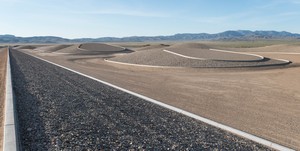
Michael Heizer’s City, an artwork over fifty years in the making, opened to the public this fall. To celebrate this momentous occasion, we are honored to publish the late Dave Hickey’s report on his visit to the City.
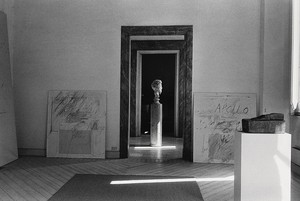
In 2020, the Museum of Fine Arts, Boston, announced their plan for a survey of Cy Twombly’s artwork alongside selections from their permanent ancient Greek and Roman collection. The survey was postponed due to the lockdowns necessitated by the coronavirus pandemic, but was revived in 2022 with a presentation at the J. Paul Getty Museum in Los Angeles from August 2 through October 30. In 2023, the exhibition will arrive at the Museum of Fine Arts, Boston. The curator for the exhibition, Christine Kondoleon, and Kate Nesin, author of Cy Twombly’s Things (2014) and advisor for the show, speak with Gagosian director Mark Francis about the origin of the exhibition and the aesthetic and poetic resonances that give the show its title: Making Past Present.
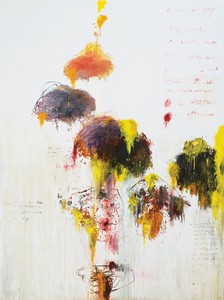
Thierry Greub tracks the literary references in Cy Twombly’s epic painting of 1994.
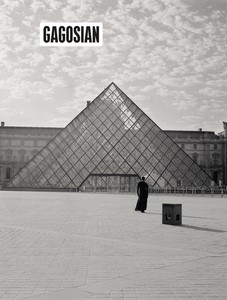
The Summer 2021 issue of Gagosian Quarterly is now available, featuring Carrie Mae Weems’s The Louvre (2006) on its cover.
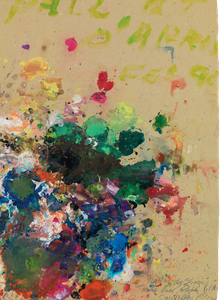
Anne Boyer, the inaugural winner of the Cy Twombly Award in Poetry, composes a poem in response to Twombly’s Aristaeus Mourning the Loss of His Bees (1973) and introduces a portfolio of the painter’s works accompanied by the poems that inspired them.

The Spring 2021 issue of Gagosian Quarterly is now available, featuring Gerhard Richter’s Helen (1963) on its cover.